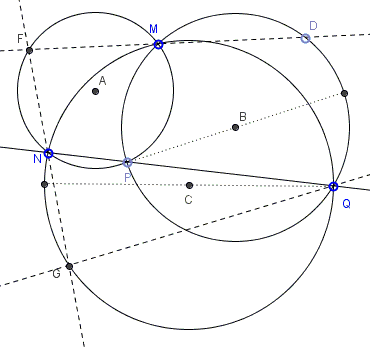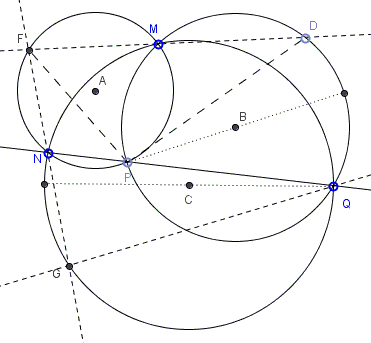Two Common Chords in Three Concurrent Circles
Points \(N, P, Q\) are collinear. For a fourth point \(M,\) consider circumcircles, \((A)\) of \(\Delta MNP\), \((B)\) of \(\Delta MPQ\), \((C)\) of \(\Delta NPQ.\) \(D\) a point on \((B)\), \(F=DM\cap (A),\) \(G=FN\cap (C).\)

Prove that, if one of the segments \(DP\), \(FP\), \(GQ\) is a diameter in the respective circle, so are the other two.
(The applet below illustrates the problem.)
Created with GeoGebra
|Contact| |Front page| |Content| |Geometry|
Copyright © 1996-2018 Alexander Bogomolny
Solution
Points \(N, P, Q\) are collinear. For a fourth point \(M,\) consider circumcircles, \((A)\) of \(\Delta MNP\), \((B)\) of \(\Delta MPQ\), \((C)\) of \(\Delta NPQ.\) \(D\) a point on \((B)\), \(F=DM\cap (A),\) \(G=FN\cap (C).\)

Prove that, if one of the segments \(DP\), \(FP\), \(GQ\) is a diameter in the respective circle, so are the other two.
If \(DP\) is a diameter of \((B)\) then, as we know, \(FP\) is a diameter of \((A),\) and vice versa.

If \(FP\) is a diameter of \((A)\) then angle \(FNP\) is right. \(FN\perp NP\), which is the same as \(GN\perp NQ\) so that \(GQ\) is a diameter of \((C),\) and vice versa.
|Contact| |Front page| |Content| |Geometry|
Copyright © 1996-2018 Alexander Bogomolny
73578894
